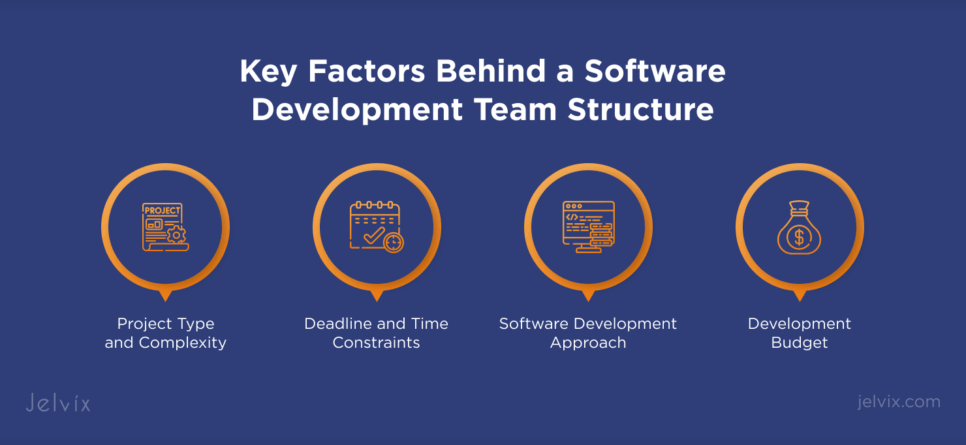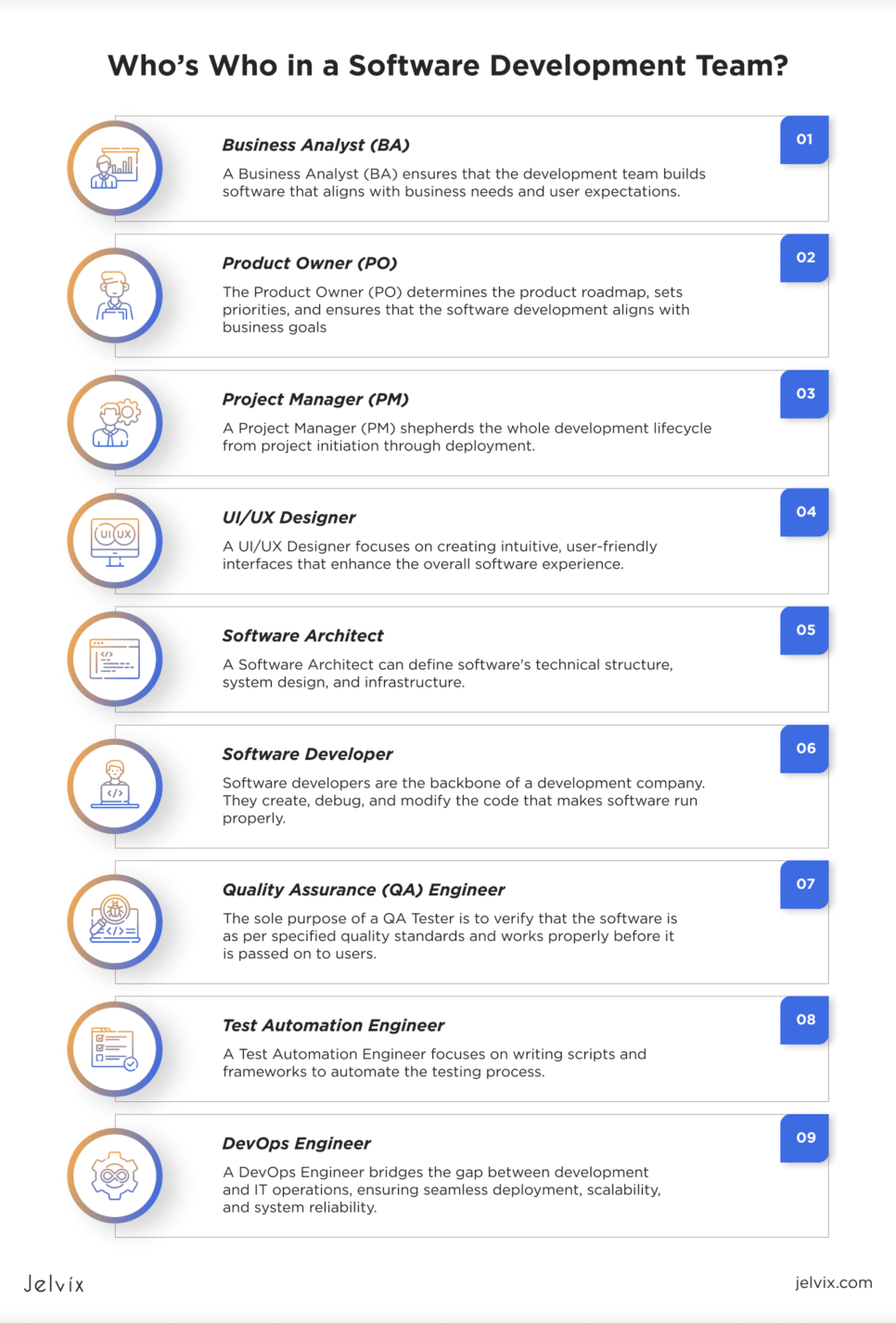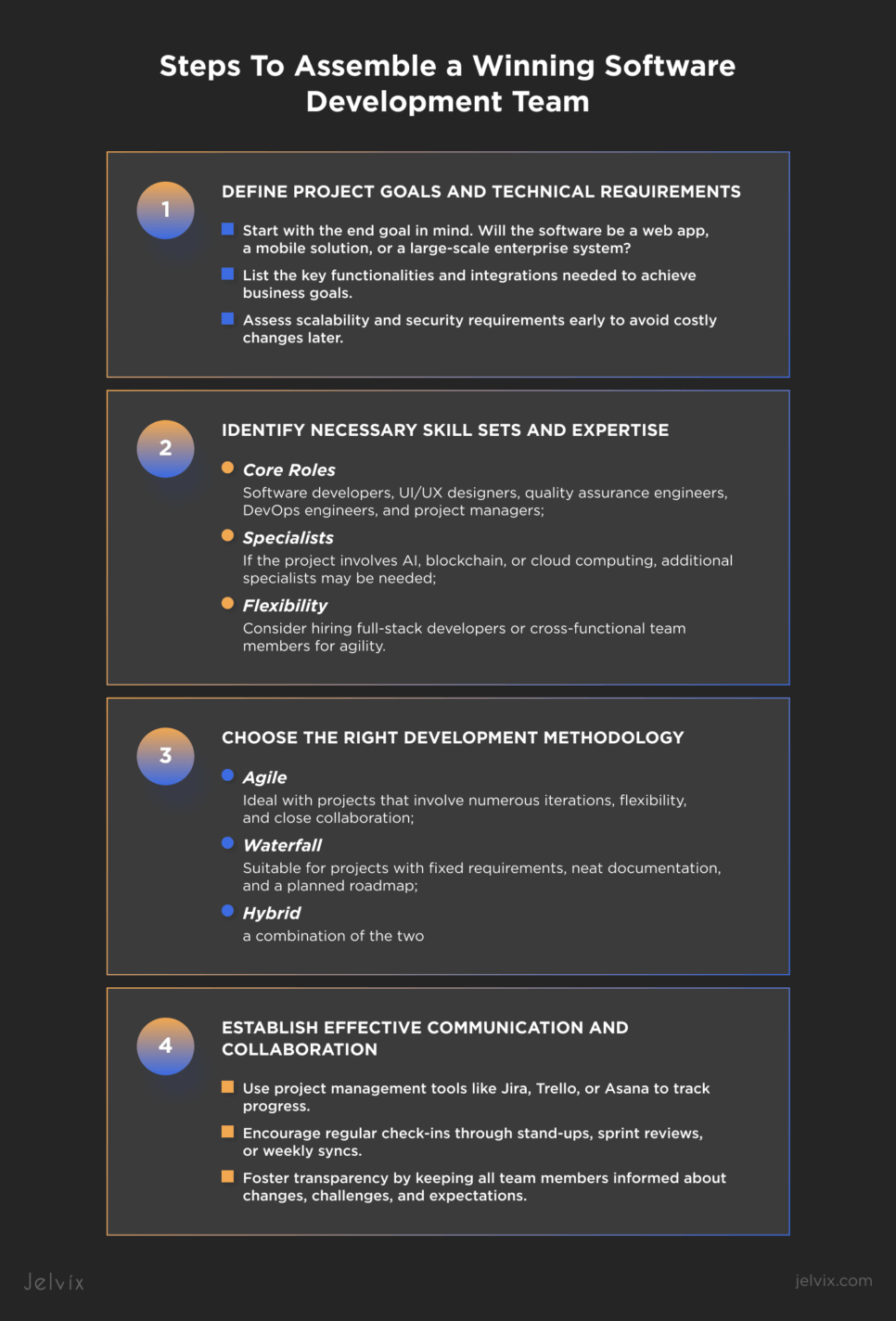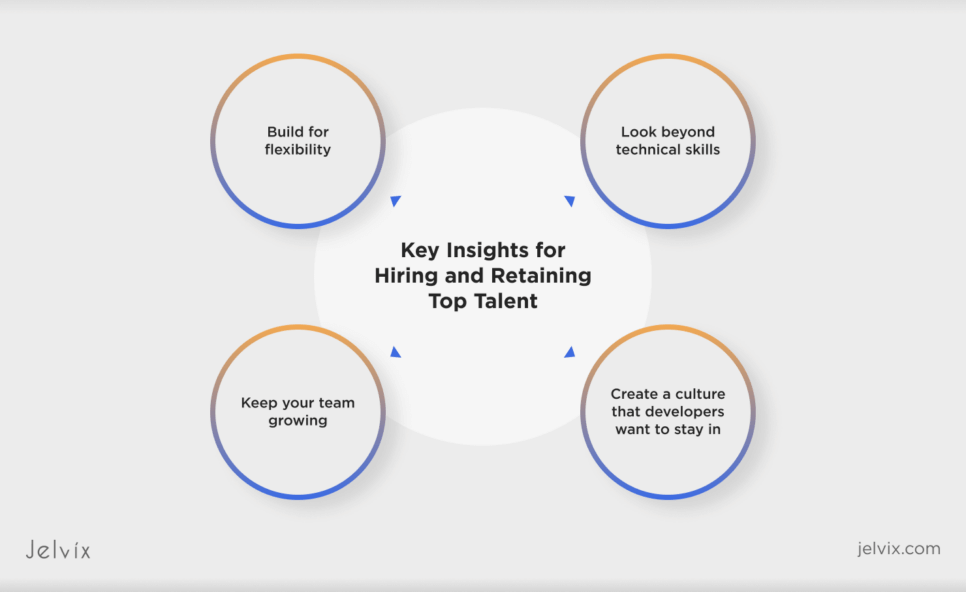Recently, if you’ve checked your inbox, you might have noticed an overwhelming number of job listings and emails from recruiters. They are searching for various positions: developers, AI engineers, project managers—whatever the role may be. Companies globally are actively seeking top-notch tech talent. And we aren’t talking only about startups here. Tech giants chronically crave skilled specialists.
This hiring boom didn’t materialize overnight. The COVID-19 pandemic simply accelerated digital transformation in all sectors. Firms competing to go virtual logically led us to remote working tools, cloud infrastructure, and security systems of various kinds.
This brings us to the present, and IT is still booming. AI-driven applications, cloud computing, automation, and data analytics have ushered in a new era for software development. As a consequence, businesses are reorganizing their teams and adopting agile approaches.
But now that demand is high, finding the right people is more challenging. Why are companies evolving their software development team structures to stay ahead? Let’s examine the answer.
Key Factors Behind a Software Development Team Structure
Building a successful software development team is not possible with a single formula. Various factors, such as the complexity of the project and the constraints on the allocated resources, affect the team’s composition. In addition, the way software is developed will also have an impact. Here’s how these elements may influence your team settings.
Project Type and Complexity
The scale and complexity of a project directly affect the structure of a team. A small startup aiming to rapidly launch a minimum viable product (MVP) doesn’t need to have the same specialization as a big company developing a large-scale AI-powered platform.
Startups usually employ small, cross-functional teams where team members wear many hats. When you’re at a company that is getting off the ground, and resources are limited, it means its engineers have to be capable of manning all aspects of development on their own.
- In this case, full-stack developers are common, handling both frontend and backend tasks to speed up the process;
- Product managers often act as business strategists. They ensure the product aligns with market demands;
- Minimal hierarchy allows for quick decision-making and fast iterations.
Speed and adaptability are critical. Startups must launch fast, gather user feedback, and improve based on real-world data. For this reason, the way these teams are structured ensures flexibility rather than specialization. All employees should feel at home in an environment that’s moving rapidly and presents new demands all the time.
Enterprises typically boast millions of users, complicated architectures, and various systems integrated into their networks. Because of the process, security concerns, and industry regulation scale, expansive projects require teams of robust and highly specialized experts:
- Dedicated software architects design scalable system structures to ensure long-term stability and efficiency;
- Backend, frontend, and database specialists work together to manage vast amounts of data and optimize system performance;
- Security experts and compliance officers ensure regulatory compliance, especially in industries such as finance, healthcare, and government software;
- DevOps engineers focus on automation, CI/CD pipelines, cloud infrastructure, and server management;
- Quality assurance (QA) teams test software to maintain performance standards across multiple environments.
Enterprise teams follow strict workflows and detailed documentation, in contrast to startups, for which agility is paramount. However, instead of fast iteration, enterprise development cycles are longer, and the emphasis is on stability, security, and scaling.
Deadline and Time Constraints
When it comes to tight deadlines—whether resulting from competition in the marketplace, pressure from investors, or contractual obligations—companies are often forced to scale up their team size to achieve delivery expectations. This can take the form of hiring more engineers or outsourcing parts of the process to specialists.
With larger teams, multiple deliverables can be worked on simultaneously. This helps reduce bottlenecks and ensures that essential features are finished when needed. But a bigger team also means a higher degree of management complexity, requiring more decisive leadership and clearly defined operations to keep everyone in line.
A flexible timeline also results in different development paths. Instead of using a large dev team to hurry up development, companies may work with a small squad of employees who systematically complete their tasks over a long period. This stretches out the development time but should lead to higher levels of quality control within deep technical refinement and better alignment with plans for prospective goals.
Smaller teams are also much less likely to suffer from serious communication breakdowns, making staying on task more manageable. A more relaxed development schedule will also make it easier for system engineers to communicate with each other and solve technical problems iteratively faster. A more relaxed timeline also means developers can spend more time on iterative improvements, testing, and optimizations, leading to a more polished final product.
Development Budget
The project’s budget is supposed to be presented in software development team structure formats. Companies must balance costs with efficiency to avoid overspending while maintaining high-quality output.
- Limited budgets (startups, MVPs) often mean smaller, full-stack teams or outsourcing to cost-effective regions.
- Large budgets (enterprise projects) can afford to invest in different specialists and dedicated QA testers, so they avoid releasing code until testing for a whole range of possible disasters has passed.
- Hybrid models combine in-house developers for core functionality and outsourced teams for non-essential features to optimize costs.
Software Development Approach
The chosen development methodology plays a crucial role in shaping a software development team’s structure, workflow, and collaboration style. It commands teams on how they plan, execute, and deliver projects, directly affecting their productivity, efficiency, and adaptability.
Agile methodologies have become the norm for startups and any venture that needs to move volumes fast and adapt to market changes. Generally, small, cross-functional teams that are highly collaborative work in short iterations that are called sprints. Agile teams test and revise their software regularly with the help of continuous feedback loops. This allows them to rapidly incorporate new features in response to feedback and make changes when necessary.
In contrast, Waterfall development follows a structured, sequential process, where each phase—requirements gathering, design, implementation, testing, and deployment—is completed before moving to the next. It would appear that Waterfall is best suited for industries where strict adherence to procedures, paperwork, and results is king, such as finance, medical institutions, and government projects.
Because Waterfall projects involve extensive planning up front, they are less prone to scope creep but offer small error margins if something goes wrong mid-project. Under such strict conditions, the teams operating within this framework tend to be large, even when individual roles—project managers, systems architects, QA specialists—are very well defined and have little crossover.
Recognizing the strengths and weaknesses of each method, many companies choose a hybrid that combines the flexibility of Agile with the planning and construction of Waterfall. This is especially common at large enterprises or on multi-phase projects: while core functions hash out structured plans in general terms, some areas remain open to change to suit different demands.
For example, a business that offers cloud-based healthcare platforms may use Waterfall principles to ensure that the core system complies with secure software while applying Agile for front-end and user experience enhancement work.
Read more about the most common software development strategies and take a look at their benefits and drawbacks.
Who’s Who in a Software Development Team?
Understanding who does what in a development team can clarify responsibilities, improve collaboration, and stop bottlenecks before they happen. Here’s a closer look at the key roles and how they contribute to successful software development.
Business Analyst (BA)
A Business Analyst (BA) ensures that the development team builds software that aligns with business needs and user expectations. They work closely with stakeholders to gather, refine, and document project requirements. This way, the abstract business goals are turned into something concrete and clear that an entire development team can quickly grasp.
Not only do BAs pinpoint possible dangers, but they are also in a prime position to suggest improvements in procedures. They also ensure that the final product is efficient in solving real-world problems.
Product Owner (PO)
The Product Owner (PO) determines the product roadmap, sets priorities, and ensures that the software development aligns with business goals. They work with stakeholders, users, and the development team to put features in order of importance, clearly define users’ needs, and maintain a well-structured backlog.
In Agile teams, the PO is responsible for refining requirements throughout sprint planning and evolving the product based on user feedback and market demands.
Project Manager (PM)
A Project Manager (PM) shepherds the whole development lifecycle from project initiation through deployment. In the meantime, they ensure that the schedule is on target and budget constraints are strictly enforced. They guarantee that projects are finished with top-quality workmanship. PMs act as a go-between for teams, manage risks, and solve any problems that are blocking work from moving on.
UI/UX Designer
A UI/UX Designer focuses on creating intuitive, user-friendly interfaces that enhance the overall software experience. They conduct user research, build wireframes, and create model designs to ensure the finished product is easy on the eye and a joy to use. By prioritizing usability, UI/UX designers play an essential part in ensuring that software works well and delivers a seamless user experience.
Software Architect
A Software Architect can define software’s technical structure, system design, and infrastructure. They make high-level decisions about technology stacks, frameworks, and system integrations to ensure the software is scalable, maintainable, and secure. Architects work with developers to consolidate development best practices, obtain greater performance, and lay the groundwork for long-term success.
Software Developer
Software developers are the backbone of a development company. They create, debug, and modify the code that makes software run properly. Depending on their expertise, developers may design front-end, back-end, or full-stack development systems focusing on various application layers.
Since code is the most important part, they also work with architects, designers, and testers to fix bugs, implement new features, and improve existing code regularly.
Quality Assurance (QA) Engineer
The sole purpose of a QA Tester is to verify that the software is as per specified quality standards and works properly before it is passed on to users. They create and execute manual and automated test cases to detect bugs, performance issues, and inconsistencies. This enables them to prevent expensive mistakes and ensure that new features do not unexpectedly interfere with the old ones.
Test Automation Engineer
A Test Automation Engineer focuses on writing scripts and frameworks to automate the testing process. By reducing the need for human intervention, they help teams find mistakes more quickly and generally enhance efficiency. Automated tests are particularly valuable in continuous integration/continuous deployment (CI/CD) pipelines, enabling teams to release updates more often while still maintaining high standards.
DevOps Engineer
A DevOps Engineer bridges the gap between development and IT operations, ensuring seamless deployment, scalability, and system reliability. They manage CI/CD pipelines, cloud infrastructure, server configurations, and monitoring tools, enabling teams to automate deployments, optimize performance, and prevent downtime. DevOps is indispensable for keeping workflows running smoothly and ensuring software is delivered with the least possible delay.
All software development roles in a team have unique functions. These members cooperatively produce the software. Whether a BA clarifies requirements for the next major iteration, a developer writes new code, or a QA engineer checks quality, each person contributes to the overall success of this project. Understanding these roles helps businesses assemble the right team, streamline development, and deliver high-quality software that meets technical and user expectations.
Why Is Setting the Right Team Essential for Project Success?
A well-structured software development team is crucial for project success. Research has proven that strong teamwork is an immutable success factor for software development projects. Decent coordination facilitates project execution and helps teams accomplish objectives sooner by bringing them together. With good team collaboration, resources are] controlled better. As a result, projects are completed on time, and the final product meets higher quality standards.
A recent study analyzing Agile teams discovered that successful projects cannot be accomplished without effective coordination, collaboration, and communication among team members. If a team can create a cooperative environment, it will better correspond to the dynamic nature of software projects and improve the quality of the project. Teams that promote such an environment for cooperation can benefit from performance and project outcomes.
Moreover, a team’s structure affects its ability to adapt to changes and manage complex tasks. A study on the influence of teamwork quality on software company team performance found that mutual trust, shared values, mutual focus, and effectively combining different kinds of expertise are crucial to high-quality collaboration. Teams whose members excel in these areas are more likely to produce higher-quality software and attain project success.
4 Steps To Assemble a Winning Software Development Team
Talented people must be recruited, and the team should be set up according to the project’s needs to ensure the right mix of skills and good collaboration. A high-quality, well-matched team can speed up development, lighten the workload, reduce errors, and improve product quality. Here are four essential steps in creating a stellar project team.
Define Project Goals and Technical Requirements
Before assembling a team, it’s crucial to clearly outline the project’s objectives, expected outcomes, and technical needs. A well-defined scope helps determine team size, required expertise, and technology stack.
- Start with the end goal in mind. Will the software be a web app, a mobile solution, or a large-scale enterprise system?
- List the key functionalities and integrations needed to achieve business goals.
- Assess scalability and security requirements early to avoid costly changes later.
Identify Necessary Skill Sets and Expertise
Once the project scope is clear, the next step is determining the roles and expertise needed:
- Core Roles: Software developers, UI/UX designers, quality assurance engineers, DevOps engineers, and project managers;
- Specialists: If the project involves AI, blockchain, or cloud computing, additional specialists may be needed;
- Flexibility: Consider hiring full-stack developers or cross-functional team members for agility.
Having the right mix of generalists and specialists prevents bottlenecks and ensures a smooth workflow.
Choose the Right Development Methodology
Your chosen approach will determine how the team interacts, the flow of work, and the efficiency of the result. With the correct methodology, the team will be prepared to change, meet deadlines, and produce high-quality products.
- Agile: Ideal with projects that involve numerous iterations, flexibility, and close collaboration;
- Waterfall: Suitable for projects with fixed requirements, neat documentation, and a planned roadmap;
- Hybrid: a combination of the two.
Adjusting your team’s structure to match your chosen approach makes everything run more smoothly, and projects yield better results.
Establish Effective Communication and Collaboration
Even the most skilled team can fail without proper communication and workflow management. Clear roles, structured meetings, and collaboration tools keep the team aligned and productive.
- Use project management tools like Jira, Trello, or Asana to track progress.
- Encourage regular check-ins through stand-ups, sprint reviews, or weekly syncs.
- Foster transparency by keeping all team members informed about changes, challenges, and expectations.
A culture of open communication and proactive problem-solving minimizes misunderstandings and maximizes efficiency.
Key Insights for Hiring and Retaining Top Talent
It takes more than hiring a team of skilled coders; the trick is building a powerhouse to ensure success. In today’s ultra-competitive IT market, finding and keeping top developers is a perpetual headache. Enterprises that want to attract top dev talent in 2025 must do more than just offer a good salary. They have to provide scope for growth, a good team culture, and work that matters.
Businesses need to recruit wisely from the outset because this can make the difference between a cohesive, productive development team and one that suffers from constant turnover and inefficiency. Here’s how you do that:
- Look beyond technical skills. The best developers don’t just write clean code. They solve problems, communicate well, and fit seamlessly into your development team structure. The coding team you employ should be like a Swiss Army Knife—versatile and compact. Look for both expertise and adaptability in your hires
- Build for flexibility. Rigid team structures slow down innovation. A combined approach that uses internally developed specialists, remotely based developers, and outsourced experts gives you the flexibility to scale when required.
- Keep your team growing. A team of developers and managers thrives on challenge. Investing in mentorship, ongoing training, and certifications maintains your staff’s edge. A staid developer is one who is looking for the next job.
- Create a culture that developers want to stay in. High pay attracts talent, but company culture keeps it. The best retention strategy is a supportive and transparent work atmosphere.
Jelvix specializes in corporate software development, helping businesses build, scale, and optimize the teams of developers they can rely on. Jelvix provides tailored solutions to meet your specific needs, whether you require an end-to-end development team structure or additional experts to support your in-house staff.
- Expert-Led Team Formation: We help companies assemble the right mix of experts for optimal performance;
- Flexible Scaling Options: From starting up a new project to extending an existing effort, our platform offers quick and easy access to first-rate developers;
- Industry Expertise: From AI-powered solutions to enterprise software, our teams bring deep technical knowledge and experience.
Partnering with Jelvix is the best way to ensure your company has the development team structure necessary for innovation, efficiency, and long-term growth.
Conclusion
Without a good team, projects are bound to encounter delays, communication breakdowns between developers and/or customers (both of which lead directly into conflict), technical debt (developing buildup does not pay off), and budget overruns. Therefore, it’s not optional for a software development team to be well-ordered; this is fundamental. The right team structure means increasing efficiency, decreasing errors, raising the quality of every project, and speeding up troubleshooting.
At Jelvix, we don’t just provide developers. We customize the team to be efficient, scalable, and geared to fit your exact needs and reach the heights of worlds above what you could imagine.
Everyone knows that a house built on the rocks falls easily. A strong development team is the foundation of each and every successful project. And today is the day to start!
FAQ
What are the biggest challenges in assembling a software development team?
Key challenges include finding professionals experienced in their field but with similar cultures and technology skills as you might already have in house. It also means managing communication problems when working remotely and balancing the budget while maintaining high-quality standards.
How do you determine the ideal team size for a software development project?
An optimal team size is dependent upon the complexity of the project, deadlines for completion, and the amount of money available. In general, small projects might require 5-7 people, while enterprise-level solutions need over a dozen people doing different jobs.
What are the best tools for managing a software development team?
Effective team management relies on tools like Jira, Trello, Asana (for project tracking), Slack, Microsoft Teams (for communication), GitHub, GitLab (for version control), and CI/CD tools like Jenkins and Docker (for seamless deployment).
How do remote and in-house software development teams compare?
In-house teams facilitate close collaboration and ensure alignment with the company culture, whereas remote teams offer access to a diverse global talent pool, cost savings, and greater scalability. Ultimately, the decision hinges on business priorities and specific project needs.
What are the most critical soft skills for a software development team?
In addition to technical skills, vital soft skills encompass problem-solving, adaptability, teamwork, time management, and effective communication, particularly in Agile settings.
Need a qualified team of developers?
Own the dedicated development team of professionals exclusively for your project.












